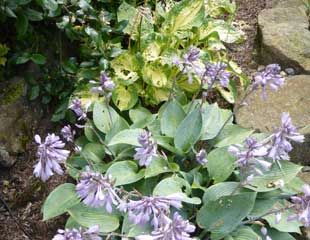Hosta care dealing with slugs and snails
Posted on
 |
 |
 |
|
Hosta are a lovely garden plant with lush green foliage in many shades of green from lime to blue. They are ideal for growing in shady areas, look very attractive set around a pond, and with ferns but they are slug and snail magnets. Some gardens suffer more from slugs and snails than others, in which case pick the varieties of Hosta which is most resistant and not the centre one. The best resistant Hosta are those with tough ribbed leaves, as in image left or blue leaves in the image below and these types stand up best. The Hosta which seem to suffer the most have the thinner leaves, often green and cream variations. To try and keep Hostas looking good you do need to keep an eye on them as not much can be done for the one in the centre image, well past redemption. But if it is just a case of a few chewed up leaves, cut them off. The image bottom left shows that in the centre of the plant there are young leaves forming and if you cut off a few of the larger, damaged leaves, the new growth will come through. Later in the growing season, and these images are taken in August, you can see in the next image bottom centre that the plant still looks good even though about a dozen leaves have been cut off and the new ones will come through. Hosta do form a lot of leaves so by August it is safe to remove a few if they are badly chewed. The further image below shows two types of Hosta side by side and some real difference in how they look by later in the growing season. The blue one is in much better shape. By later in the season the flowers on most Hostas look tatty and it is very tempting to cut them off, but inexplicably, the bees continue to like them and as I walk past the plants several bees are landing on the sad looking flowers so best to leave them there. Finally the further bottom images are a counter balance to the shredded Hosta leaves and a reminder of how lovely Hostas can look if the snails and slugs can be kept at bay. More about growing Hostas |
 |
 |
 |
 |
 |
 |

Add a comment: